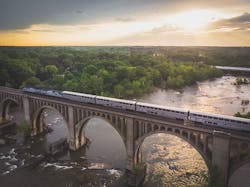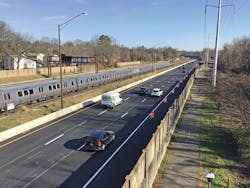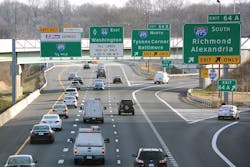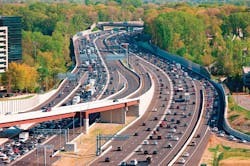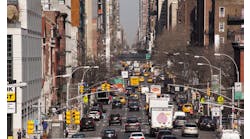Virginia takes innovative approach to transportation problem-solving
By: Ben Mannell, AICP
Virginia, like so many other growing states, is faced with a continual transportation dilemma: How to best accommodate population growth and support the associated transportation needs with limited revenues and increasing costs.
The answer: The Commonwealth is focusing on performance-based planning, using today’s readily available big data to identify transportation problems at a corridor level. Performance-based planning provides a holistic approach to problem identification and serves as the basis for targeted solutions that most effectively address underlying transportation issues.
Targeted solutions can come in many forms, such as examining lower-cost operations and demand management alternatives before committing to major capital investments. This can be seen in recent major efforts on interstate corridors within the Commonwealth. In 2018, Virginia developed its first interstate corridor improvement plan on I-81 in western Virginia—a significant freight route. The resulting plan led to legislation that provided funding for interstates across the Commonwealth, including more than $2 billion in dedicated funding to the I-81 corridor over a 10-year period for a slate of improvements ranging from operational upgrades and multimodal investments to highway capital improvements. Gov. Ralph Northam’s 2020 Omnibus Transportation bill enshrined this statewide approach by including all Virginia interstate corridors under an Interstate Operations and Enhancement Program with dedicated funding.
THE INTERSTATE OPERATIONS AND ENHANCEMENT PROGRAM: A CASE STUDY
The I-81 model now being applied to other interstate corridors—including I-95 and I-64—is a comprehensive, corridor-level strategy that crosses modes of transportation to find the best solutions. I-95 is one of the most heavily traveled corridors in Virginia—indeed on the East Coast—and its challenges are numerous. I-95 is a corridor that mirrors I-81 in its rural nature south of Richmond, transforming into an urban and truly multimodal corridor as it approaches Washington, D.C. As such, I-95 cannot be addressed with a single transportation solution; “the Virginia way” means looking at a multifaceted effort to address transportation needs on this vital corridor.
This approach begins with combing through transportation data sets to identify key problem areas. The Commonwealth, in turn, engages with the public to validate these data points and incorporate travelers’ input into the process. Following validation, a stepwise approach centered on targeted solutions begins. The first step is to maximize the efficiency of existing infrastructure—this entails a corridor-level review of operations upgrades to the interstate (including cameras, changeable message signs, towing and quick clearance of incidents, motorist assistance patrols, ramp metering, and variable speed limits), as well as improvements to parallel facilities (e.g., signal upgrades and coordination) that can become de facto interstates during incident situations. These represent low-cost solutions that yield a high return on investment.
On I-95, Virginia has dedicated approximately $65 million to such operational upgrades, which include innovative initiatives such as the Regional Multi-Modal Mobility Program (RM3P)—a collaboration among state and regional transportation entities using information and communications technologies to optimize system performance, improve travel-time reliability, and support on-demand multimodal trip options by providing the traveling public with information to make informed transportation decisions. RM3P builds on earlier Integrated Corridor Management planning studies in the Northern Virginia (NoVa) region, which took a multimodal, multiagency approach to dynamically managing travel conditions and traveler behavior through a corridor. The Commonwealth is also advancing variable speed limits as a means to address congestion south of Fredericksburg—an area on the cusp of the D.C. exurban area that experiences periodic bouts of extreme traffic congestion.
Once operations upgrades have been evaluated, multimodal solutions are considered: Does the corridor and surrounding land-use support expanding ride-sharing, transit, or rail? Are there major intercity freight and passenger services using the corridor? Are there sufficient ancillary facilities, such as park-and-ride lots, to support these modes?
Providing multimodal options across the transportation network
Multimodal options present a lower-cost solution to moving people along critical corridors. In NoVa, those options include Omniride in Prince William County, Fairfax Connector, and the services provided by the Washington Metropolitan Area Transit Authority: Metrobus and Metrorail.
The practice of maximizing Virginia’s fixed assets is evident on interstates as well. I-95 includes 31 miles of express lanes (soon to be 41 miles as they are expanded southward) that are part of a network of more than 90 miles of uninterrupted express lanes the Commonwealth is developing across the 95, 395, 495, and 66 corridors in NoVa. The benefits of the express lanes network are being realized now more than ever, with an emphasis on moving people rather than vehicles.
Transit and multimodal improvements are a key part of the network, and have been included in agreements and project scopes with private project partners. The attention to multimodal travel options is intentional—funding agreements with private operators were designed to leverage transit investments to increase person throughput on these key travel corridors. For example, the I-66 Express Lanes Outside the Beltway scope includes the private partner building two new park-and-ride lots with more than 3,200 new commuter parking spaces, as well as a bike and pedestrian trail adjacent to I-66 and across I-66 bridges, and providing $500 million to fund projects in NoVa including pedestrian improvements, shared-use trails, and enhancements to a Virginia Rail Express (VRE) station, a bus facility, and a bus bay at a Metro station.
This commitment to transit is also a key part of I-66 Express Lanes Inside the Beltway. The VDOT-operated I-66 Express Lanes exemplify how managed lanes and transit can achieve transportation goals without adding lane capacity. These express lanes operate during weekday peak periods, within existing lanes that previously were restricted to non-carpoolers. The dynamically tolled lanes move more people with greater efficiency, without requiring more pavement.
Toll revenues from the I-66 Express Lanes Inside the Beltway, as well as the privately funded and operated I-395 Express Lanes Northern Extension, are reinvested to fund multimodal improvements benefitting the I-66 corridor. Through the Commuter Choice program, managed by the Northern Virginia Transportation Commission (NVTC), 43 projects have been funded by toll revenues from these two express lane facilities. More than $64.3 million of toll revenues have supported these projects, which include capital assets such as bus purchases, park-and-ride lot construction, and capital improvements to bus stops. Projects funded through the Commuter Choice program move about 2,200 people each morning in the I-66 and I-395 corridors, reducing single-occupant vehicle use and congestion.
Virginia developed a program of transit/transportation demand management (TDM) services to be funded with these annual dedicated revenues. The plan includes recommendations to fund an additional VRE commuter rail service parallel to the corridor, as well as new commuter bus services and transportation demand management options. The investments outlined in the plan are anticipated to increase person throughput in the corridor, while maintaining single-occupant vehicle use at 2019 levels, preserving the investment in the highway infrastructure for many years to come.
The I-495 NEXT project, which will extend express lanes to the American Legion Bridge, represents the final link in the NoVa express lanes network that will eventually connect to Maryland’s, creating a seamless transition across the Potomac River. Both states are actively working together on a transit/TDM study for the corridor.
All of these improvements provide low-cost and reliable travel options to commuters, remove vehicles from congested roadways, and help to optimize the transportation network by moving more people.
Changing the transportation dynamic
As the express lanes network is nearing completion, the public is experiencing the benefits, especially in improved travel reliability. This network not only provides a more dependable travel option for single-occupant vehicles (SOVs), but it also provides the backbone for the expansion of the region’s transit network, as carpools, vanpools, and buses can access the express lanes network for free. The Commonwealth’s investment in this network has already led to shifts in travel behaviors, as certain interstate corridor segments with express lanes are seeing more than 60% of persons moved in non-SOV forms of transport during peak periods. Strategic investments in managed lanes maximize use of the state’s existing infrastructure in a region where building and expanding roads is difficult.
During the development of the new I-95 Corridor Improvement Plan, the Commonwealth looked at what it would take to expand I-95 by one travel lane in each direction between the Capital Beltway to south of Fredericksburg—a distance of 52 miles. The cost totaled a staggering $12.5 billion, with congestion predicted to return to pre-build levels shortly after it would open.
These findings helped drive the Transforming Rail in Virginia initiative, through which the Commonwealth is doubling down on its investment in multimodal transportation infrastructure in the NoVa region and beyond. A preliminary agreement with CSX and Amtrak will lead to dedicated track for passenger and commuter rail service along the 95 corridor and an expansion of the Long Bridge over the Potomac River, one of the most notorious rail bottlenecks along the entire East Coast. Freight and passenger rail services have different missions and requirements, but like tractor trailers and cars, they share the same infrastructure. The initiative will directly address these constraints and allow Virginia to expand Amtrak and commuter rail services, advance the separation of freight and passenger rail in Virginia, and preserve future rail corridors. Passenger rail provides a cost-effective solution in the short and long term. Within the next 10 years, this arrangement will allow for additional service that can accommodate the same number of persons that a lane of interstate highway can during peak periods for a fraction of the cost.
The investment in rail infrastructure, born out of the performance-based, targeted-solution, corridor-level planning approach, will create more efficient and sustainable transportation options, not just along the I-95 and I-66 corridors in NoVa, but across the entire Commonwealth. It provides the basis for improved rail service throughout Virginia, enabling expanded intercity rail service to both Newport News in eastern Virginia and Christiansburg/Blacksburg in southwest Virginia.
The I-95 Corridor Improvement Plan is now entering its final phase: the development and evaluation of targeted capital solutions. This is being done in parallel with targeted capital solutions on the I-64 corridor, the only other interstate corridor with dedicated funding through the Interstate Operations and Enhancement Program. These corridors are not only going through a comprehensive, multimodal planning process that incorporates lessons learned from other regions, but they are benefiting from a performance-driven approach that seeks the best solution to underlying problems.
Why performance-based planning matters
A targeted approach is absolutely critical for NoVa, a region whose population is expected to grow by 20% over the next 20 years. It is no secret that a high-caliber, multimodal transportation system attracts businesses and stimulates investment in our communities. According to The Washington Post, in the first 10 months of 2019, NoVa gained an average of 19,500 jobs from a year prior. Yet, this region was recognized by traffic research firm INRIX as one of the worst traffic hot-spots in the nation. NoVa faces daily congestion, unpredictability, and mobility demands, as well as growth in employment and activity centers. It is crucial that the improvements we make to our transportation network keep up with and support this growth.
Investments in capacity and infrastructure in one part of the state impact the entire state. Across Virginia, travelers currently experience 230 million hours of vehicle delay each year, resulting in $6.5 billion in annual congestion costs. The I-66 corridor carries nearly 200,000 vehicles per day in its busiest sections with coordination between transit services and connections seeing incremental improvement. In Hampton Roads, the Commonwealth’s largest-ever construction project is underway to expand the I-64 Hampton Roads Bridge Tunnel, which moves more than 100,000 vehicles daily during peak travel periods. The Bridge Tunnel will be a critical link in a new network of almost 45 miles of express lanes in Hampton Roads that will deliver additional travel options and increased travel reliability. The tunnel and the express lanes network will also benefit The Port of Virginia’s facilities, which handle 4 million containers annually from all around the world, 980,000 of which are moved by truck across the Commonwealth and beyond. Current conditions and increasing demand mean more throughput capacity is needed along all of Virginia’s interstate corridors.
So how do we continue to accommodate growth with limited revenues and increasing costs?
It is essential that the Commonwealth continue to employ a multimodal mindset in the planning process. Solutions like the Interstate Operations and Enhancement Program—that take a performance-based, multimodal approach—will be key to sustained progress addressing issues statewide related to reliability, travel flow, and safety along critical travel corridors. By identifying operational improvements, multimodal projects, and capital investments, such an approach fairly and comprehensively evaluates high-impact travel corridors and develops targeted, effective solutions. And it will ensure that the Commonwealth’s multimodal transportation network continues to support a thriving, ever-growing Virginia economy.
About The Author: Mannell is Assistant Director of Planning in the Transportation and Mobility Planning Division of the Virginia DOT.
